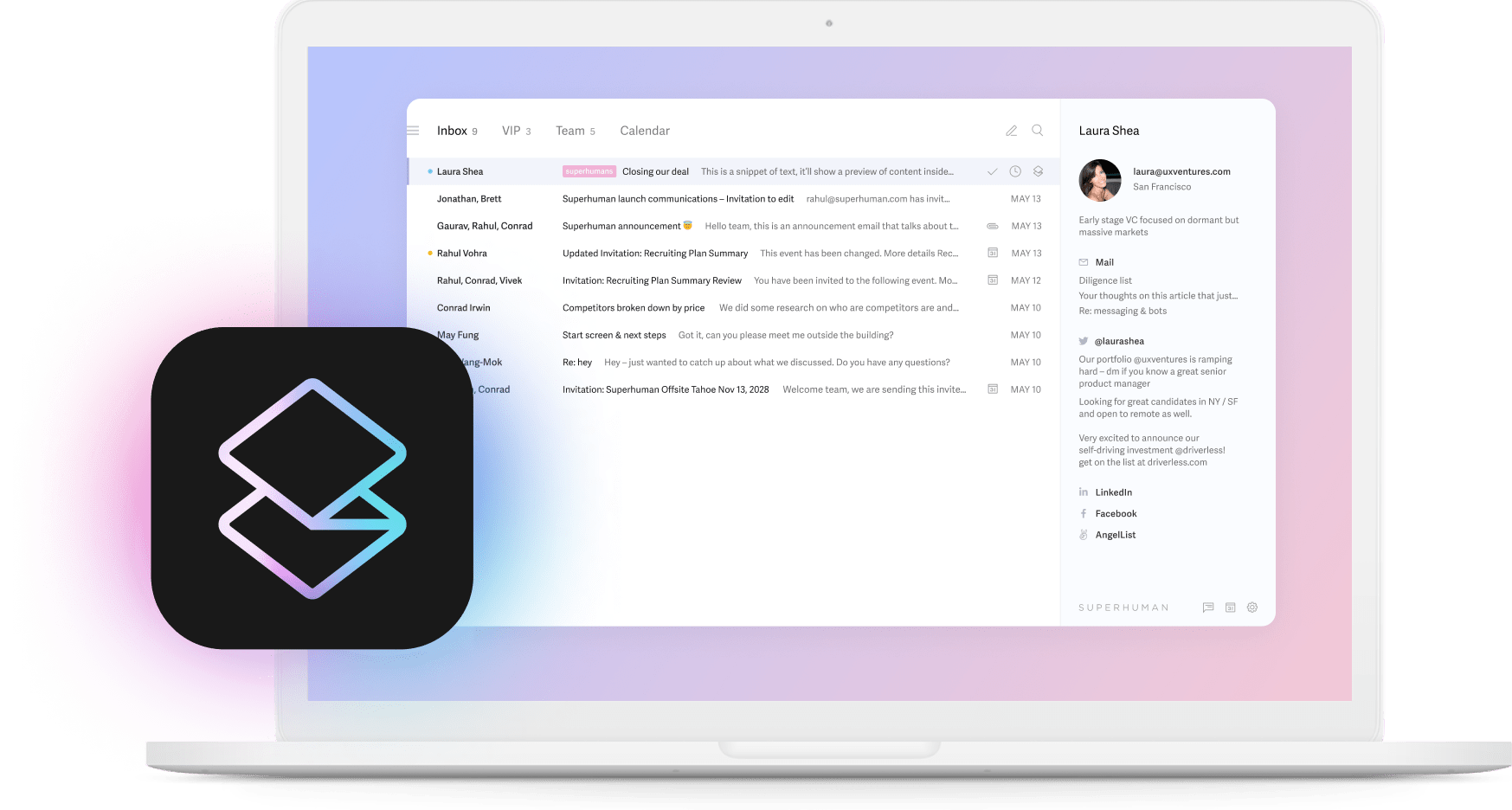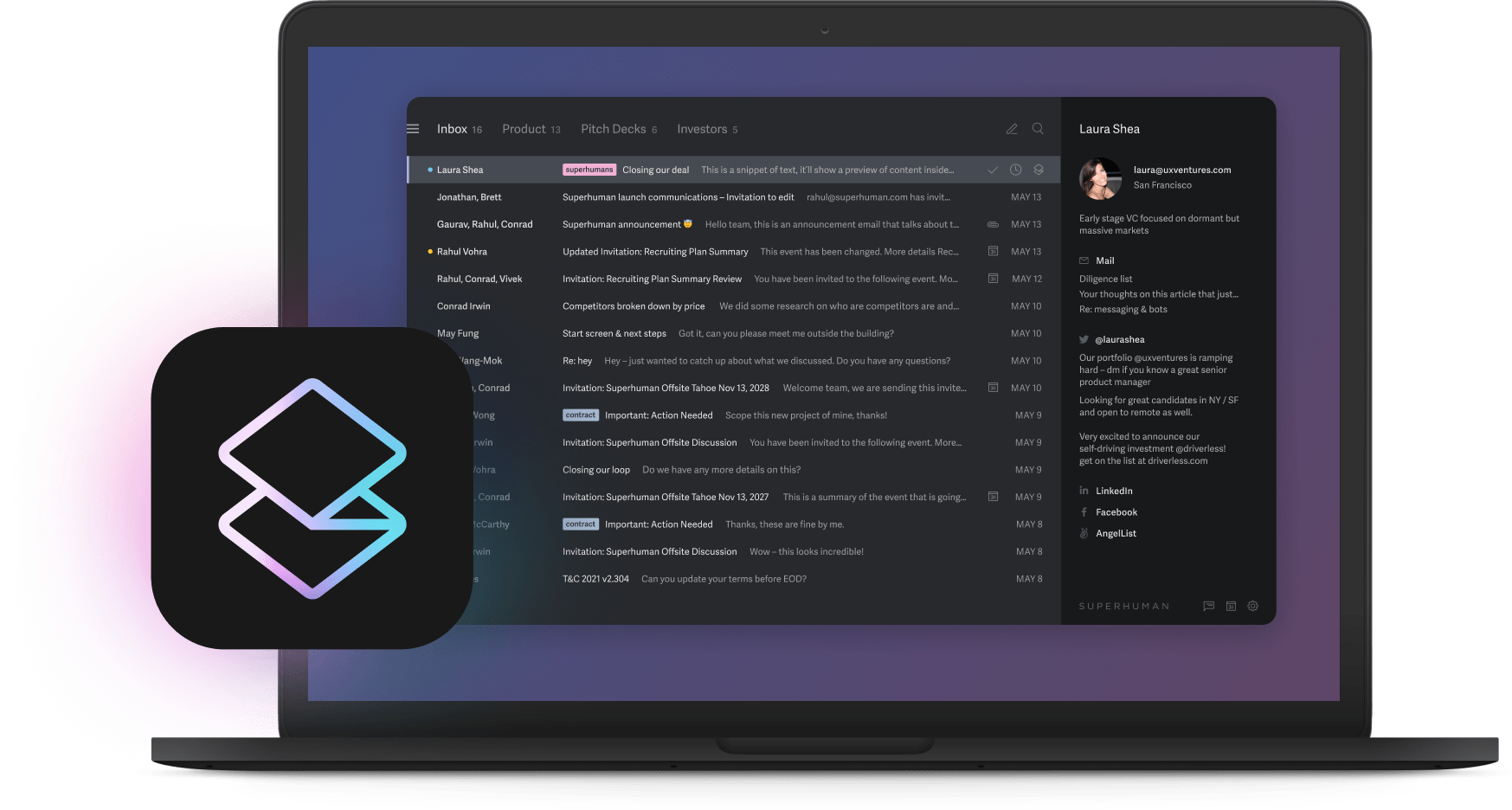
Writing a cold email is a delicate art.
A well-written cold email can help you recruit your dream hire, close a big sale, and raise funds for your business. Poorly written outreach is skimmed and ignored, or worse, marked as spam.
Emails that seize interest, build rapport, and achieve your goals can seem challenging to craft — but they don’t have to be. By following a few simple rules, your cold emails will yield incredible results.
What is a cold email?
A cold email is an email you send to someone you don’t have a relationship with. Yet. But you're trying to close a sale, an interview, or an exciting partnership, starting with a cold email.
In the non-digital world, you might meet a new potential client at a conference. You don't jump into a sales pitch when you start your first conversation with them. There are pleasantries and getting-to-know-you questions. You're just trying to break the ice.
Online, this is where a cold email fits in. You're hoping to build and maintain a relationship with the recipient, but the cold email is just the first part of the conversation.
Does cold emailing even work?
Despite laws against it, spam is at an all-time high — in fact, one study found that around 85% of all emails are spam. Our inboxes tend to be noisy, cluttered, and full of distractions. Considering that landscape, is cold email even an effective outreach strategy?
The truth is that research from Pitchfunnel showed that 91.5% of cold outreach emails are ignored. But that means that 8.5% of them get engagement — your goal is to be part of the 8.5%.
One email can change everything, especially for a startup.
When we first cold-emailed Emuye Reynolds — who later became our head of engineering — she was already choosing between 7 jobs!
How did we land our dream hire? Following cold email best practices and writing effective cold emails inspire recipients to take action.
Anatomy of a cold email
There are certain elements you must include when crafting outreach emails — regardless of whether you're wooing a potential new hire, selling your software to enterprise supply chain managers, or winning press coverage for your brand-new product.
1. Craft an enticing subject line
If you can't pique their interest with your subject line, they'll never even open your email. You'll be relegated to the trash folder with all the other cold emails, or worse, marked as spam!
Your subject line should be clear and not overly clever. By reading the subject line, your reader should know what the email is about and be intrigued to open it.
For great subject lines, Hubspot created a list of 100 examples from top brands. You can use some of these examples of promotional, curious, funny, pain points, and social proof subject lines to craft the perfect subject line for your outreach.
2. Use hyper-personalization to build connection
Personalizing outreach or cold emails can make the difference between responding to your email and junking you.
Make sure that you mention something public and not too personal — but make it something that shows you know something about their work.
The degree of hyper-personalization can seem challenging, but it doesn't have to be if you do your homework. A recent product launch or rebrand, a tweet they posted that went viral, or an award they recently received are just a few Google clicks away.
3. Add humor sparingly
Most outreach emails require a level of professionalism. You're introducing yourself to the recipient, and you want them to take action — so you want them to see you in the best possible light.
But your recipient is human; all humans like to smile and laugh. Taking a casual approach to writing your outreach and incorporating a little well-judged humor goes a long way in breaking the ice. Just don't overdo it, and use humor sparingly.
3. Include a simple and singular call to action
A cold email needs to have a call to action (CTA). You want them to do this once they've read your email.
Should they schedule a meeting via your Calendly? Sign up for a free trial of your product. RSVP to an event by a specific date.
Ask them to do only one thing, and make it easy for them to do that thing. Anything more — or worse, no call to action at all — and the recipient won't know what to do.
How to write a cold email: A 7-step guide
Writing an effective cold email is a multi-step process that takes time and practice to perfect. But as you hone your skills, writing emails will become more straightforward — and your success is guaranteed to increase.
Here's a downloadable cheatsheet to help you write better emails:
It includes our favourite subject lines, cold email templates, follow-up email templates, and more!
Time to cover the 7-steps on writing a cold email:
Step 1: Research your recipient
The research required for sending a cold email is two-pronged:
- First, you need to find a recipient and their contact information.
- Second, you need to learn about them to personalize your message.
There are many ways to find leads (and their email addresses). Manual research (i.e., databases or LinkedIn) is the cheapest and most labor-intensive way. Using a lead-generation company is faster but can be expensive. Social media like LinkedIn is a popular place to research cold email outreach because it's easy to find decision-makers who work in industries relevant to you and your product/service, meet people through mutual connections, and find and verify email addresses.
Once you have your recipient's email address, research the lead. Find relevant information about them that can help you determine a common touchpoint, like their job title and company, social media activity, and hobbies and interests. You'll use this information in Step 2.
Step 2: Personalize your message
Use your research from Step 1 to get your prospect's attention and make a good first impression!
It can be difficult to strike the right balance — to make a cold email feel personal without becoming too intimate, informal, presumptuous, or over-the-top. Remember that you don't need to take a deep dive into the recipient's life: a recent product launch, a tweet they just sent, or an award they recently received are all easy to find and will help you personalize your cold email in a way that's likely to catch their attention.
Step 3: Write a compelling subject line
An email's subject line is the first thing the recipient will see — even before the opening line of the message itself. Writing a great subject line is both an art and a science, and it's one of the hardest things to master when learning to craft a great email.
The subject line directly impacts the open rate of your messages, so the best cold email subject lines should make the recipient want to click through and learn more. They should be short and intriguing, posing a question the rest of the email will answer.
Here are some subject line best practices to keep in mind:
- Your subject line should be ten words (25-30 characters) max. 42% of email opens happen on mobile devices, so you must optimize your subject line for small screens.
- Personalize the subject line. Using the recipient's name in the subject line can increase open rates by 29%!
- Use your email's most surprising or impressive line as the subject line.
- Be specific. A statistic like "Superhuman cuts email time by 50%" is more effective than "Superhuman makes you faster at email".
- Highlight a common pain point for their industry. Then, promise a solution.
Here are some examples of great subject lines in action:
- Have you tried [solution] for [pain point]?
- X tips/ideas to [succeed with your solution]
- X% of [counterparts in the same function] is loving [solution]
Recommended Reading: How to format an email? (+5 examples)
Step 4: Tell the recipient what's in it for them
There's no way to inspire action with a cold email unless it contains a value proposition for the recipient.
The central part of the email body should be this: your pitch to the recipient. But remember not to make your first cold email too salesy. Talk about the benefits of your solution, not the features. Use social proof if you have any (like reviews from other customers or a testimonial from a past contact).
Answer the age-old question the recipient likely has: "What's in it for me?"
Putting yourself in their shoes is an excellent way to check whether your cold email proposes value to the recipient. Read your email from the recipient's viewpoint and ask yourself, "What does this email provide for me?"
Step 5: Include a call to action
Your subject line and the end of your email are the two most vital pieces.
To end an email, tell the recipient what to do next if you've piqued their interest. Include a call to action (or CTA) that tells the recipient exactly what you want them to do.
Some examples we love:
Let's schedule a 10-minute call next week to review more details if you'd like to learn more.
Please join me for a virtual coffee this Thursday or Friday if you are interested. Your coffee is on me!
Would you rather have a phone call or a Zoom meeting for our next step? Let me know which you prefer, and a few times you have available over the next week or so.
Further Reading: How to end an email.
Step 6: Follow up as needed
Remember how 91.5% of cold emails get ignored? You're facing some long odds, so don't feel bad if your first email doesn't get your desired response. People are busy, and their inboxes could be clearer. Sometimes, even the best email hits the wrong time and gets lost through the cracks.
This is why follow-up emails are a crucial part of the cold-email process.
A good follow-up email should use the same principles as the cold email — an attention-grabbing subject line, a value proposition, and a clear CTA for the recipient. The important thing about the follow-up is ensuring you send it at the right time.
There are many ways to track email communication (if you send many cold emails, a CRM may help you create a sound system for your outreach). Automation is another way to keep track of follow-ups — like Superhuman's automated follow-up reminders, which can help ensure you never leave a lead hanging.
Step 7: Track your email metrics
Finally, you should monitor metrics to see when your cold emails are working — and when they aren't. Some good metrics to track include:
- Open rates
- Response rates
- Reply rate
- Conversion rates (a conversion, in this case, following your CTA, whether scheduling a call or responding for more information).
A/B testing different types of cold emails (while tracking whatever metrics are most impactful for your specific goals) is one of the most tried-and-true ways to determine what works in an email.
7 cold email tips and best practices
Incorporate these bonus cold email tips for the best results:
1. Keep it short (<100 words)
The most successful cold emails are concise yet impactful. That's hard to do, but it's essential — emails that contain between 75 and 100 words achieve the highest response rates. Try to edit your email copy to less than 100 words whenever possible.
"I didn't have time to write a short letter, so I wrote a long one instead," – Mark Twain.
Writing concisely is incredibly difficult. But it's worth the effort. Emails between 75-100 words get the highest response rates.
Writing Tip: Writing less means writing more! Rewrite each sentence three times, making it shorter in each draft.
2. Lead with the "reciprocity principle"
Sincere, personal invitations increase the likelihood of a reply. Social psychologists call this the reciprocity principle.
Our subject line seeks connection, not transaction. We tailor the opener to Emuye's expertise without being overly familiar. And we don't bury the lede; the opportunity is captured in the first line.
Notably, the email came directly from our co-founder, Vivek — inviting Emuye to connect with a key decision-maker.
Writing Tip: Tighten greetings and delete apologetic openers. ("I hope you don't mind me emailing…" They do mind, now you've put the idea in their head!)
3. "Read the room" to determine the right tone
Should your cold email be more formal or more casual? Somewhere in between? Nailing the tone in an email to someone you haven't yet connected with is incredibly hard — especially since, unlike in-person interactions, you can't use nonverbal cues to adjust your approach on the fly.
This is another area where your research about the recipient can be helpful. Pay attention to the tone in their social media posts and other online content, and try to mirror that. Superhuman's Social Insights can help — they allow you to see key social media information about your recipient without leaving your inbox.
Also, keep in mind how your target audience should impact the tone you use. For example, a recruiter can generally strike a friendlier, more casual tone when contacting a prospective employee than a salesperson trying to land a new client.
When in doubt, always err on being more formal and professional.
Further Reading: How to write an effective email that inspires action
4. Proofread before hitting "send"
Every email writer's worst nightmare is hitting send and realizing, moments later, that they made an embarrassing mistake, like misspelling the recipient's company name (or worse, the recipient's name).
Proofread every email carefully to avoid these mishaps. But mistakes can still happen. Use Superhuman so you can unsend an email before it's too late.
5. Optimize for F-shaped scanning
Research shows that most email recipients don't read messages word-for-word — they perform "F-shaped scanning."
You've already loaded vital information up top. Now, write bullet points to match their F-shaped scanning.
This means you want to craft your message so its overall shape is like a capital letter "F" — the most crucial information is up top, and all other vital parts are in bullet points underneath. It should look like this:
What should you include?
- Highlight the company's wins and wows!
- Then, answer the 5 Ws (who, what, where, why, when) to pre-empt possible questions.
Writing Tip: Assume impatience — succinctly capture the opportunity and company mission. We sometimes add "[read time: 43 secs]" to subject lines to assure recipients of a quick read!
6. Create a template for faster, easier outreach
Using a cold email template can be controversial. Your email does need to be personalized to stand out and achieve the highest chances of getting engagement from the recipient. But you can start with an email template to jumpstart the outreach process quickly.
Using Snippets in Superhuman allows you to store pre-written messages and insert them into your messages with a quick keyboard shortcut. Then, you personalize them based on what you know about the recipient before sending them.
7. Send messages at the right times
Determining the best time to send emails is more art than science.
But testing different send times can help your message land in a recipient's inbox when they're most likely to open, read, and engage with it. And that's easy to do with Superhuman's Scheduled Sends.
Scaling cold email outreach
Once you get the hang of writing cold emails, the next step is making it easier to send them. With a tool like Superhuman, you can make sending outreach emails easier and perfectly timed.
Here's how it works:
Email templates
If you're thinking, "But you just told me always to write customized outreach emails," you'd be right. Email templates (or Snippets in Superhuman) allow you to store pre-written templates that you can customize for each email.
Your email format doesn't always have to change. Still, the specifics do — that's why Superhuman makes it incredibly fast to personalize emails with names, attachments, and other recipients in the CC field!
Optional Reading: CC vs BCC: How to use them.
Undo send
We've all been there: we press "send", and not a microsecond later, we realize we forgot to attach a file, include that all-important link, or give the day and time of the meeting.
If you're in marketing or journalism, an email with typos can damage your brand. If you're in recruiting, spelling a candidate's name wrong (or calling them by the wrong name altogether!) can harm your credibility and ruin goodwill.
Those email whoopsies are why it's invaluable to undo sending cold emails. Otherwise, you'll make the opposite of a good first impression. Superhuman's Undo Send feature allows you to avoid these costly mistakes.
Schedule send and Remind Me
Another game-changer when sending out cold emails is scheduling them for a later date and time. This can be particularly helpful if you're working late and don't want the recipient to know you were up at 4:04 AM… Instead, schedule your email to go out at 8:15 AM, when they'll be getting ready to start their day and more likely to read it. In Superhuman, you can even schedule a send for different time zones without calculating them yourself.
Scheduling reminders can be just as helpful. In Superhuman, you can schedule reminders to follow up on your outreach emails if you don't hear back within a week or a fortnight.
Superhuman lets you know if your recipient opened your email. You can schedule follow-up emails at the right time.


(Optional) Cold email vs spam: What’s the difference?
The intent of a cold email should be to establish a business connection and build rapport with a recipient or recipients. On the other hand, spam is purely an advertisement for a commercial purpose sent to a recipient who doesn't want to receive it.
While you can send a one-off cold email to a cold lead or as a message to a list of people, it's crucial to note relevant anti-spam laws and be sure your message doesn't violate any.
In the US, that means following the CAN-SPAM Act. To comply with the law, a marketing email must:
- Use an informative header that allows the recipient to identify who the message is from quickly
- Use an accurate subject line
- Identify if the message is or contains an ad
- Contain a physical postal address for the sender or business
- Include an easy way to opt out of future emails (either by replying to the first email or visiting a single webpage to unsubscribe)
- Honor opt-outs promptly
In the EU, marketers must follow the General Data Protection Regulation (GDPR), which has guidelines similar to US law but with one big difference: it's an opt-in law rather than an opt-out. That means businesses can only send sales emails to potential customers if they obtain their consent to do so in advance.
The good news is that CAN-SPAM's requirements only apply to email with the primary purpose of "commercial advertisement or promotion of a product or service." That means that if you write a quality cold email that's personalized and intends to establish a relationship with the recipient rather than jumping right into trying to make a sale, your message will likely be compliant.
The GDPR is more broad since it covers data security and privacy for all EU citizens. While the law has some gray areas regarding email marketing, experts generally agree that it all comes down to consent — the recipient must agree to receive communication from you and have their data used how you're using it.
They can also withdraw consent at any time. Sending a personalized cold email and simply asking the recipient if they're open to further communication from you should satisfy the law and stay out of the recipient's spam folder.
Cold emailing: Wrapping up
Studies show that the average person sends and receives 126 work-related emails daily. This means your email competes with 125 others for the recipient's attention. Learning how to write better emails is crucial to stand out.
Writing emails (especially cold emails) is a skill like many other things. You can learn how to write a cold email like a pro with the right knowledge and some practice. You have the knowledge. Go ahead and start sending cold emails!
Superhuman helps you send powerful, impactful cold emails — on top of being the fastest email experience in the world. Sign up today!




